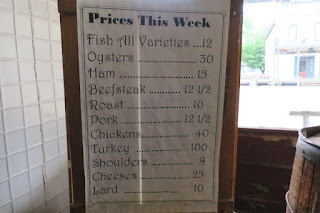Witicha, KS grew in this spot as a result of the proximity of three major travel routes-- the Arkansas River, the Chisolm Trail, and the Santa Fe Railroad, and because of the rich black soil of the prairie.
Witicha today
This view is taken from the museum district where you can visit several museums clustered there.
When the cattle business collapsed, the city switched to shipping wheat.
To preserve the city's history, Old Cowtown Museum was established.
You enter on the left. There are two streets. The rear street has harness shop, livery, grain elevator, rr depot, and a road out of town to a farm. The time period represented is 1865--1880. The Victorian Era is well represented in the city's architecture and costumes.
You can see these houses on the far left of the diorama. The house on the left is upper middle class business owner, the one on the left is lower middle class laborer.
Typical business
Several costumed interpreters were on hand--the farmer,
blacksmith,
citizen,
law enforcement,
milliner or ladies clothier
printer, (although today he was the undertaker).
Inside the one room Masonic hall--quite a contrast to the magnificent Temple in Guthrie
We visited some buildings we had not seen in other living history museums.
Marshall's office--the frame on the wall holds brass tags that were attached to weapons as they were checked at the office. It was unlawful to be armed within the city limits (see below).
Some interesting information.
A fun little quiz
and the answer is
A meat market--besides beef, wild game was available.
This would be in cents. Seafood was expensive, but turkey was apparently in even shorter supply.
Speaking of prices, I told the general store clerk that I would take the lot.
This is the first city jail in Wichta, built in 1871. Duane couldn't keep me here.
My bad jokes finally got to him.
The undertaker explained that I should invest in this beautiful resting place to show everyone how much I loved him. Many people went into debt for the rest of their lives to make sure everyone knew that their dearly departed were well loved.
We also learned that at first there were no funeral parlors. Furniture makers made coffins and most wakes were in peoples homes. The word undertaker came into being during the westward migration. Many newly deceased had no relatives to tend to them. Church members would volunteer to under take getting them ready for burial. Embalming was distained also until the distances became too great for any relatives to arrive in a timely manner.
On a brighter note, people did love their cheerful colors
and eye-bending designs.
Another unusual sight--wine for sale in the Druggist's shop,
and an advertising case clock with monthly calendar.
Notice the year--1876
We really enjoyed this living history museum--a new type for us. Wichita is a city worth visiting
and their museums are first rate. If you are in the area, be sure to check it out.
Louise and Duane
































1 comment:
I just love living museums. I am just going to start telling everyone how much I love Paul, so I don't have to show it later...hehe
Wonder what alcohol content that wine is. We just bottle our first batch and it is 14%. Those must be around 60%.
Post a Comment